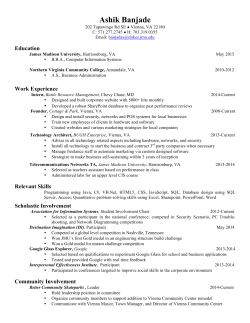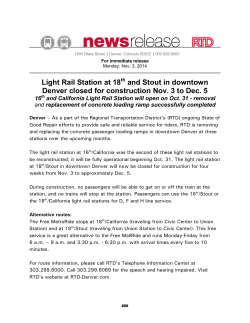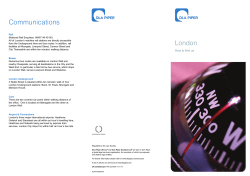
SARAIL Safety Assessment Rail
Test Sets for the traffic sector: Safety Assessment Rail SARAIL Safety Assessment Rail The train driver’s job involves considerable responsibility. The combination of constant concentration, monotonous work, fast speeds and shift work places drivers under significant stress. Because of the danger potential and the level of responsibility, the use of psychometric suitability tests for selection and regular testing of train drivers is mandatory. The SARAIL Safety Assessment Rail test set in the Vienna Test System HR helps rail companies identify the best train drivers. Tests that can be used to supplement SARAIL SARAIL covers 14 ability dimensions. In addition, the SCHUHFRIED portfolio contains many other tests that may be relevant to drivers of rail vehicles. These include personality tests for testing aggression, alcohol dependency, mental stability, self-control and sense of responsibility. To meet the requirements profile of other staff in the rail industry (e.g. staff in customer service or administration), the test set can be supplemented by other tests. Adapting SARAIL to company-specific needs Company-specific questionnaires or knowledge tests (e.g. to test knowledge of regulations) can be added to the SARAIL test set by using the Test Generator. Specially created norms can also be imported. Upon request the SCHUHFRIED consulting team will be happy to assist with the necessary calculations. The respondent database, the reWorth knowing sults report or the ranking can be Tests enable recruitment adapted to your particular needs to be objective, fair, standardeither by you or with assistance ized and structured. from SCHUHFRIED. 30 . Vienna Test system HR Using SARAIL after an incident The test set can be used to conduct a strengths and weaknesses analysis of the drivers involved. On the basis of the results, individual training plans can be drawn up. This specific approach boosts the effectiveness Worth knowing of the intervention. Biofeedback 2000x-pert and the cognitive training program CogniPlus enable staff development measures to incorporate products that are coordinated with tests. Test Sets for the traffic sector: Safety Assessment Rail Overview of the SARAIL Test Set SARAIL Safety Assessment Rail Author SCHUHFRIED GmbH Application The test set SARAIL Safety Assessment Rail is a sophisticated and flexible tool for testing train drivers’ fitness to drive. SARAIL identifies whether train drivers meet the requirements of the European Train Driver’s License. Fourteen cognitive, psychomotor, behavioral and personalityspecific abilities are tested. As well as being used to test train drivers, SARAIL can also be used to select drivers of other rail vehicles (e.g. rapid-transit train, metro, tram) and applicants for safety-related jobs in the rail sector. The test set can be used with respondents aged 18 and over. Theoretical background Selection of the ability and personality tests included in the SARAIL test set was based on EU directive EU/2007/59/EC, which requires not only ability dimensions but also personality dimensions to be assessed. In methodological terms the tests used meet the highest standards of modern psychological and psychometric assessment. Administration Administration of the test set is flexible and can be adapted to the requirements of the specific setting. Dimensions can be removed from the test set and breaks can be inserted. Scoring The candidate’s results on the individual dimensions are displayed both in a table showing the raw score and percentile rank norm score and in a profile. A report containing a written description of the test results can be created if required. Dimensions The SARAIL test set comprises the following tests and dimensions for assessing ability and personality factors relevant in the field of rail psychology: Tests Test form/Subtest Reliability Length in minutes Concentration COG S11 0.95 approx. 5 Vigilance WAFV S2 0.96 approx. 32 Memory VISGED S11 0.73 approx. 13 Logical reasoning INSSV S2 1 0.78 approx. 151 Verbal ability INSSV S2 0.741 approx. 101 Dimension Attention Cognitive abilities Reactive behavior & visual functions Stress tolerance, reactive DT S1 0.99 approx. 6 Reaction time RT S3 0.94 approx. 6 Visual perception LVT S2 0.92 approx. 13 2HAND S3 0.96 approx. 4 Sensomotor functions Eye-hand coordination Work-related aspects of personality 1 Emotional stability BFSI Social confidence, Emotional robustness 0.83 approx. 2 Extraversion BFSI Sociability, Assertiveness 0.83 approx. 2 Conscientiousness BFSI Sense of duty, Ambition 0.93 approx. 2 Openness BFSI Openness to actions, Openness to ideas 0.9 approx. 2 Agreeableness BFSI Genuineness, Willingness to help 0.83 approx. 2 Total length approx. 114 Provisional estimate on the basis of the data available to date. Vienna Test system HR . 31 Test Sets for the traffic sector: Safety Assessment Rail The description of results in the SARAIL Test Set The test results are available as soon as testing ends in the form of a chart (“profileˮ), a table and a Word report. Cognitive abilities Profile In the profile diagram the normal range is shaded grey, so that deviations as well as strengths and weaknesses are immediately obvious. Stress tolerance, reactive Reaction time, simple: reaction speed Reaction time, simple: motor speed Sensomotor functions Table The table lists the results and relates them to the scores of a comparison group. It shows the test variables, the raw scores obtained and the corresponding norm scores. Word-Report The test results can be transferred into a report template with a click of the mouse. This report can be edited, printed and saved using Microsoft Word®. Read more ... about these three versions of the description of results on page 14–15 Ranking The additional Ranking module can be used to compare a number of respondents and list them from best to worst in order of performance. Read more … about the ranking on page 15 32 . Vienna Test system HR Cognitive abilities Stress tolerance, reactive Reaction time, simple: reaction speed Reaction time, simple: motor speed Sensomotor functions Test Sets for the traffic sector: Safety Assessment Rail References The Vienna Test System is the international standard for the targeted measurement of all the special abilities needed in safety-related jobs. It is the leading and internationally recognized instrument for computerized psychological assessment. No other test system has been more frequently DB GesundheitsService GmbH, Germany Until 2006 a company affiliated to Deutsche Bahn AG chosen by international rail companies than the Vienna Test System. All these companies have used the Vienna Test System with great success and to their complete satisfaction. A selection of our customers’ projects and testimonials. SBB Personal Diagnostik, Switzerland Part of a Service Center of Schweizerische Bundesbahnen SBB AG “For more than a year now we have been trying out the twelve individual tests from the Vienna Test System that we have acquired, using them in pilot form for assessments carried out within Deutsche Bahn AG and for other customers. Our experience of using the equipment and the individual tests can be summarized as follows: The daily use of the Vienna Test System […] has not revealed any significant problems. The equipment is reliable. By far the majority of the people who have taken the tests have had either no problems or only very minor ones in coping with the system in the way in which we use it. The use of the VTS has played a significant part in optimizing our suitability assessment procedures and making them more flexible. […] When the system was introduced it was a great help to us that your technical department was able to take account of distinctive local features and incorporate them into the set-up. Once again, many thanks for that.ˮ Indian Railways, India Indian state railway company with a country-wide monopoly on rail transport “We wish to acknowledge the services rendered by your company during supply of Vienna Test System (VTS) to Indian Railways with great satisfaction. During our visit to your company […] we got an opportunity to interact with your scientific personnel. We were amply impressed by their professional attitude and depth of knowledge. We specially appreciate your gesture for providing technical support in analysis of data, collected on VTS during the preliminary trials on Indian Railway personnel. […]ˮ Other rail companies that use the Vienna Test System: “Since 2001 we have been incorporating the Vienna Test System (VTS) into our procedures, using its different components to clarify a range of issues relating to performance and personality assessment. In choosing the VTS we were influenced both by the content of the system and by economic considerations. The company’s scientific approach and its wealth of experience were also important factors. For the last four years we have been using more than 40 VTS systems at locations all over Switzerland and we make use of a range of tools and tests in German, French and Italian. The tests are used for the following types of assessment: ii Suitability tests for train drivers ii Individual aptitude assessments for train drivers ii Investigations for other safety-related functions ii Assessment of potential for a range of jobs and functions ii Selection tests for a range of jobs and functions […] The VTS is simple and economical to use as an assessment tool. It is also easy to make temporary changes to the tests or the method of scoring if required. We very much appreciate the clear and straightforward presentation of results. Since our work involves using the VTS all over the country with different customers and for the clarification of different issues, we need flexible software with which we can quickly incorporate changes (layout, own norms etc.). In these respects we are very satisfied with the VTS, and we should particularly like to highlight the very skilled and reliable customer service which deals quickly and simply with our individual needs. […]ˮ Rail DBGS GmbH (Deutsche Bahn AG) Dutch Railways Österreichische Bundesbahn Queenlands Rail, Australia Swedish Railways Vienna Test system HR . 33
© Copyright 2025










